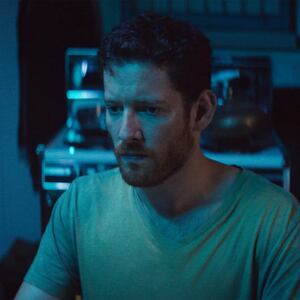Nature can be neither opposed nor fled in In the Earth, which—following last year’s misbegotten Rebecca, that never fit his gonzo sensibilities—returns writer/director Ben Wheatley to the hallucinatory strobe-lit horror insanity of his 2014 gem A Field in England. A stripped-down genre affair shot during quarantine and infused with deeply rooted pandemic fears, it’s a phantasmagoric folky freak-out that, like a pestilence, gets under one’s skin, where it festers and infects with unnerving potency. Perched on the razor-thin boundary between lucidity and madness, it gnaws at the nerves and bludgeons the senses until submission—to humanity’s helplessness in the face of the ancient world’s elemental power—is the only recourse.
Produced in 15 days in August 2020, In the Earth (now playing) is not only a companion piece to Wheatley’s A Field in England—a mushroom-fueled psychotronic nightmare par excellence—but also to Alex Garland’s Annihilation, sharing a narrative focus on scientists venturing into a toxic heart of darkness, where they find brutal violence and trippy 2001-style lunacy. The primary subject of Wheatley’s latest is Martin Lowery (Joel Fry), an unassuming researcher who arrives at a remote English facility where pandemic protocols are the order of the day. No one explicitly identifies the disease that everyone is afraid of, but in drips and drabs, the film reveals that it’s extremely deadly, and that it’s ravaged the country (and planet), including the city where Martin’s elderly parents reside.
At this outpost, a country home retrofitted for medical purposes, Martin meets Alma (Ellora Torchia), a park ranger who’s been assigned to accompany him into the dense forest to rendezvous with his former colleague Dr. Olivia Wendle (Hayley Squires), who’s carrying out unspecified tests in the middle of nowhere. Before embarking on their two-day hike to Olivia, Martin spies a painting (and related kids’ drawings) of a fabled pagan spirit of the woods known as Parnag Fegg that captured locals’ imaginations in the 1970s after some children went missing in the area. It’s no great leap to assume that this myth is somehow related to the film’s opening sight of a towering stone slab with a hole in it (think a more earthen variation of 2001’s alien monolith). Yet at least initially, Martin shrugs off this tall tale, his attention less on campfire stories about monsters than on a practical mission that involves doing outdoors-y things he’s not very skilled in, like building a tent.
Things quickly take a harrowing turn. First, the duo come upon an abandoned tent strewn with toys and a book about a witch, suggesting that a family has been hanging out in this forbidden zone. Then, they’re viciously beaten in their own tent by an unseen assailant. Shortly thereafter, they come upon Zach (Reece Shearsmith), a reclusive outdoorsman who offers them assistance—including shoes, since theirs were pilfered by their attacker—back at his surprisingly sizable makeshift home, replete with its own disinfection station. Zach is a sketchy hermit, but since they’re in desperate straits, and Martin is also suffering from a giant gash in his foot, the pair accept his assistance—which, wouldn’t you know, turns out to be an unwise idea.
Referring to Parnag Fegg, Alma states, “I think the forest is like something that you can sense, so it makes sense that they should give that fear a face.” Later, she tells Martin she believes people will soon forget about their pandemic ordeal and go back to their prior ways, implying that mankind is incapable of truly respecting, or coming to grips with, nature’s awesome and terrifying might. In this hostile environment, amateur shutterbug Zach opines that “photography is like magic, really. But then, so is all technology when you don’t know how it works.” The supernatural quality of the unknown is everywhere in In the Earth, and Wheatley uses canted compositions in which his characters are dwarfed by their lush, misty surroundings to conjure an atmosphere of the mysterious, primal world devouring these interlopers, consuming and reintegrating them back into its fertile soil.
The director’s dreamy aesthetics are amplified by a soundscape of menacing electronic noises, heavy breathing, and unnatural bird calls, creating the impression that this milieu is not simply alive but sentient. The interconnectedness of everything soon becomes a pressing concern for Martin and Alma, including with regards to Zach—whom they must escape, because he’s up to some wild stuff—and Olivia, who’s trying to commune with the primeval stone slab that she believes is the embodiment of Parnag Fegg, and the hub of the country’s ecological bio-network. To do this, she employs methods that are at once technological and ritualistic—a marriage of the rational and irrational that soon defines In the Earth, and also channels The Shining and the filmmaker’s Kill List as it spirals down, down, down into an abyss of schizoid craziness.
Wheatley’s suspenseful visuals alternate between spying Martin and Alma at a remove and engulfed by tangled branches and heavy foliage; close-up views of flapping-skin wounds that gush blood and are stitched up with makeshift sutures; and kaleidoscopic montages of blooming flower petals, smoke tendrils, sunlit-dappled tree tops, smashing rocks, pouring rain, crawling bugs, and other unsettling images. The ethereal and corporeal are intertwined here, portending doom. No concrete explanation for what’s going on is provided; shrewdly, In the Earth’s rare bouts of exposition are handled so quickly that specifics are deliberately hard to discern. What is clear, however, is that man holds little sway over nature (and its old gods), and any attempt by the former to comprehend the latter is an endeavor destined to confound, if not drive one out of their ever-loving mind.
In its bewildering final moments, the film delivers the head-spinning payoff promised by its preceding passages. In the Earth doesn’t make complete sense because it’s a movie about incomprehensibility. Tapping into our ongoing COVID anxieties of corruption and ruin, it’s a sinister vision of nature protecting itself through biologically and psychologically viral defense mechanisms—and of the futility of trying to change, fight, reason with or even fathom such unstoppable forces.


